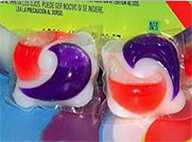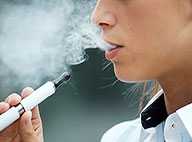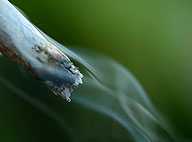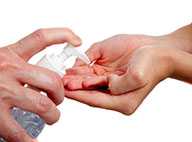National Chemical and Radiological Surveillance Program
Program highlights reflect diverse topics from poison center surveillance
Did you know?
CDC works with poison centers to protect the nation from public health threats.
Roughly every 8 minutes, call data from poison centers across the country are uploaded to a national reporting database and electronic surveillance system called the National Poison Data System (NPDS). The Centers for Disease Control and Prevention (CDC) and the American Association of Poison Control Centers (AAPCC) use the database to improve surveillance of chemical exposures and public health hazards.
Learn how public health surveillance identifies and responds to incidents of public health significance from poison center data with this flowchart [PDF - 121KB].
CDC and AAPCC scientists monitor NPDS every day, watching for any data anomalies that may represent incidents of potential public health significance such as outbreaks of illness. They are ready to spring into action to assist with further activities such as surveillance or conducting a public health investigation. See our printer-friendly fact sheet [PDF - 208KB].
Anyone can alert poison centers to an exposure of concern. Callers can contact the Poison Control Center in their area by calling 1-800-222-1222. Individual callers will automatically be connected to the center covering their calling area. For an online option, this AAPCC interactive tool prompts users to answer a few simple questions about a human exposure to approximately 325,000 available unique products and substances.
Improving Consumer Safety for Laundry Pods (2012)
 From May 17–June 17, 2012, poison centers across the country reported 485 cases of children being exposed to detergent-filled laundry pods. CDC partnered with AAPCC and poison centers in Charlotte and Philadelphia to investigate this public health threat. Their work helped contribute to the decision by the largest manufacturer of laundry detergent pods in the United States to add a double latch lid safety feature to their containers. Manufacturers have also worked with poison centers to study risk factors and health outcomes linked to laundry detergent pods exposures.
From May 17–June 17, 2012, poison centers across the country reported 485 cases of children being exposed to detergent-filled laundry pods. CDC partnered with AAPCC and poison centers in Charlotte and Philadelphia to investigate this public health threat. Their work helped contribute to the decision by the largest manufacturer of laundry detergent pods in the United States to add a double latch lid safety feature to their containers. Manufacturers have also worked with poison centers to study risk factors and health outcomes linked to laundry detergent pods exposures.
Reporting Poisoning from Electronic Cigarettes (2014)
 Electronic cigarettes, or e-cigarettes, are devices that allow users to inhale an aerosol that typically contains nicotine, flavorings, and other additives. While long-term impacts of these products on public health are uncertain, one area of concern is the potential for poisonings. A CDC study found that 2,405 e-cigarette exposures were reported to poison centers from September 2010 to February 2014. This work informed a number of public health actions including the Child Nicotine Poisoning Prevention Act of 2015, enacted in January 2016. This law requires any container of liquid nicotine that is sold, manufactured, distributed, or imported into the United States use packaging that is difficult for children under 5 years of age to open.
Electronic cigarettes, or e-cigarettes, are devices that allow users to inhale an aerosol that typically contains nicotine, flavorings, and other additives. While long-term impacts of these products on public health are uncertain, one area of concern is the potential for poisonings. A CDC study found that 2,405 e-cigarette exposures were reported to poison centers from September 2010 to February 2014. This work informed a number of public health actions including the Child Nicotine Poisoning Prevention Act of 2015, enacted in January 2016. This law requires any container of liquid nicotine that is sold, manufactured, distributed, or imported into the United States use packaging that is difficult for children under 5 years of age to open.
Increasing Awareness of Synthetic Cannabinoids (2015)
 CDC launched an investigation in April 2015 after being alerted to an increase in poison center calls related to synthetic cannabinoids, also known as synthetic marijuana. The results, published in MMWR, led to a surge in media coverage on this issue that created a broader awareness of issues and dangers of using synthetic cannabinoids.
CDC launched an investigation in April 2015 after being alerted to an increase in poison center calls related to synthetic cannabinoids, also known as synthetic marijuana. The results, published in MMWR, led to a surge in media coverage on this issue that created a broader awareness of issues and dangers of using synthetic cannabinoids.
Shedding Light on the Dangers of Hand Sanitizers (2017)
 In March 2017, MMWR published a report that described reports of exposure to alcohol-based hand sanitizer in children. Analyzing reports from poison centers across the country, CDC scientists uncovered health risks to younger children and possible emerging abuse of products for older children. Their findings shed light on the potential dangers of hand sanitizers and the need for better safety precautions and supervision for the children who use them.
In March 2017, MMWR published a report that described reports of exposure to alcohol-based hand sanitizer in children. Analyzing reports from poison centers across the country, CDC scientists uncovered health risks to younger children and possible emerging abuse of products for older children. Their findings shed light on the potential dangers of hand sanitizers and the need for better safety precautions and supervision for the children who use them.
Tracking Concerns during Japan Radiological Event (2011)
CDC tracked all calls to poison centers related to the 2011 Japan nuclear event. Between March 11 and April 18, NPDS tracked 340 information requests and 64 calls regarding potential radiation, potassium iodide and iodide product exposures. Call details were analyzed daily and reported to CDC leadership for situational awareness and to inform public health response efforts. CDC and AAPCC staff performed detailed follow up and data review to confirm exposure status. Surveillance for calls related to potassium iodide (a preventive treatment for radiological-associated thyroid disease when radioactive iodine is released) exposures documented very few adverse outcomes in persons taking this product in response to a perceived risk from this event. This work reassured CDC leadership that potassium iodide abuse in response to this incident was not a substantial public health concern.
Oil exposures from Deepwater Horizon Incident (2010)
As of September 11, 2010, 1838 calls were received by 57 poison centers related to the Deepwater Horizon explosion and oil spill. Of these, 1160 were self-reported exposures and symptoms, including cough, nausea, headache, eye irritation, throat irritation, chest pain, dizziness, difficulty breathing, and rash. The data was used to identify trends and monitor severity of health effects. This information helped CDC leadership determine impact of the oil spill on health. Information was also shared with states to aid in their public health response.
Peanut butter salmonella outbreak (2009)
Peanut butter and peanut butter containing products were confirmed to be the source of a Salmonella outbreak in January of 2009. In response, AAPCC and CDC began monitoring calls to NPDS using daily reports of calls about peanuts/peanut products. Through NPDS-based surveillance, we identified five states reporting exposure calls that had not been previously identified by CDC. Aggregate data from NPDS were reported daily to the Division of Foodborne and Mycotic Diseases at CDC to enhance their situational awareness.
Selenium exposure from a dietary supplement (2008)
NPDS-based surveillance was used to identify potential cases of selenium-associated illness associated with an improperly formulated health product and track the geographic extent of the outbreak. As of June 4, 2008, 170 exposure calls related to this outbreak were reported in eight states. Use of NPDS enhanced situational awareness for individual poison centers and state health departments, provided rapid identification of calls from newly affected states, and enabled public health officials to conduct detailed follow-up with individuals reporting exposures to these products.
- Page last reviewed: March 15, 2017
- Page last updated: March 17, 2017
- Content source:


 ShareCompartir
ShareCompartir